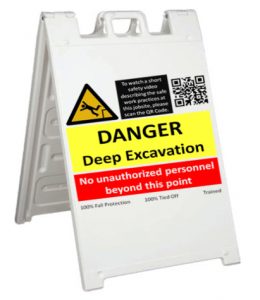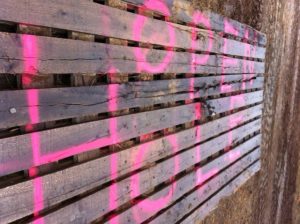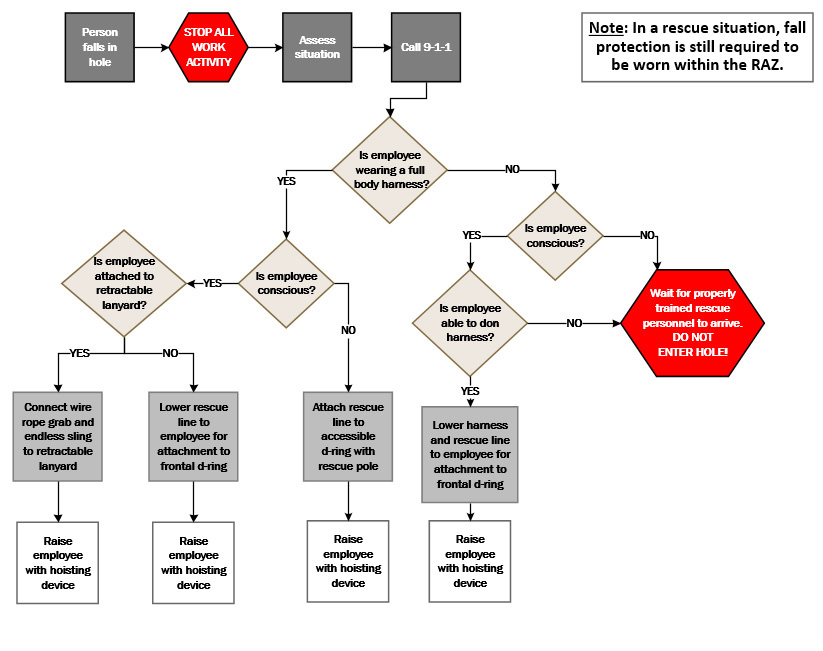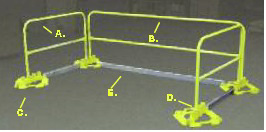Safety Around Drilled Holes – Pier or Direct Embed Foundations
Purpose
This Best Practice provides guidance for improving safety when working around drilled holes on distribution and transmission projects. Operating Units have the responsibility to put in place those measures that best protect employees. This Best Practice represents the soundest methods for reducing incidents and ensuring employee safety, based on experience and other learnings. To the extent an operating unit deviates from this Best Practice for Drilled Holes ‐ Pier or Direct Embed Foundations based on some unique features of the working environment or project, the operating unit must analyze and carefully document the alternative measures that will be utilized, ensuring that they provide at least as much protection to the workplace and employees as this Best Practice.
Objective
To more effectively eliminate, mitigate or control hazards associated when working around drilled holes on distribution and transmission projects.
Scope
This Best Practice applies to crews tasked with working around drilled holes on distribution and transmission projects greater than 30 inches in diameter, with depth greater than 6 feet, for pier or direct embed foundations.
Definitions
Anchorage ‐ a secure point of attachment for lifelines, lanyards or deceleration devices. Anchorages used for attachment of personal fall arrest equipment shall be independent of any anchorage being used to support or suspend platforms and capable of supporting at least 5,000 pounds per employee attached.
Full-body harness ‐ an approved device using straps secured in a manner that will distribute forces over the thighs, pelvis, waist, chest and shoulders with means for attaching it to other components of a fall arrest system.
Restricted Access Zone (RAZ) ‐ an area around the drilled hole that is restricted to those employees performing necessary tasks. The RAZ should be established a minimum of six (6) feet from the edge of the drilled hole. Should it become necessary for an employee to enter within the restricted access zone, the employee shall wear a full‐body harness and be tied off to a suitable anchorage utilizing a self-retracting lifeline.
Self-‐retracting lifeline ‐ an approved deceleration device containing a drum‐wound line which can be slowly extracted from, or retracted onto, the drum under slight tension during normal worker movement, but at the onset of a fall automatically locks the drum and arrests the fall.
Procedure ‑ Drilling Process (Holes Greater than 30″ up to 48″ in Diameter)
- Locate drill site and confirm structure number. Verify the presence of a current Underground Utility Locate Ticket. Survey the area to identify and confirm the presence of any potential underground and/or overhead encumbrances that could impact the job set-‐up. Confirm the presence of any known or suspected underground utility.
- Evaluate the work area ground conditions and surrounding environment. Ensure adequate ground stability where equipment will be stationed or positioned.
- A specific Job Briefing or Job Task Safety Analysis (JTSA) for drilled holes must be completed. Roles and responsibilities of all crew members will be listed on the form. Updated Job Briefings or Job Task Safety Analysis (JTSA) must be completed any time the working conditions or job activities change in a significant way from the original plan.
- Perform and document all necessary equipment inspections.
- Position digger/drill rig and all other associated equipment at the designated drill location.
- Prior to start-‐up of the drill rig, effectively place a warning line system around the swing radius of the drill rig. To increase awareness, employees should be wearing high visibility clothing or a minimum of Class 2 reflective vests around the drilling operation. Warning line system can be established by using:
- Cones (with rope, chain or some additional barrier between the cones)
- Snow/construction fencing
- Ropes
- Chains
- Caution/Warning tape
- Combination of the above
- Other
- Place a Restricted Access Zone (RAZ) around hole before it reaches six (6) foot in depth. The RAZ can be established by using:
- Guardrail System
- Cones (with rope, chain or some other additional barrier between the cones)
- Snow/construction fencing
- Ropes
- Chains
- Caution/Warning tape
- Combination of the above
- Other
A warning sign will be placed on or near the entrance to the RAZ noting job site hazards and the need for fall protection. Should it become necessary for an employee to enter within the RAZ, the employee shall be wear a full‐body harness and be tied off to a suitable anchorage utilizing a self-‐ retracting lifeline. There must be a sufficient number of anchorages to not allow the self-‐retracting lifeline to cross over the hole.
 (Sample Wording)
(Sample Wording)NOTE #1: All full-‐body harnesses used for when working around drilled holes for structure foundations or direct embed distribution and transmission poles must be specifically selected and approved for this type of work. The harnesses are designed for rescue in a horizontal position.
NOTE #2: No one shall enter within the RAZ system without having received a job briefing on the work being performed, wear all appropriate personal protective equipment (PPE) and received the required training. - Signage should be placed at the entrance to the jobsite warning all other employees, customer/client and the general public of the work taking place and the specific hazards associated with the task. All signage used on the jobsite shall be in the language(s) according to the make-up of the crew.
- Measurements ‐ Employees periodically take depth measurements during the drilling process. When it becomes necessary to enter inside the RAZ, to take measurements, employees are required to wear a full-‐body harness and be tied off to a suitable anchorage utilizing a self‐retracting lifeline. The ground conditions around the hole should be evaluated to determine if extra footing (mats, boards, etc.) needs to be in place for the person evaluating the hole. There should be a sufficient number of anchorages to NOT allow the self-retracting lifeline to cross over the hole. Only authorized employees should be in the area during drill operations. No employee can enter within the RAZ while the auger is rotating.
- Employees designated to be in fall protection must be identified and documented on the job briefing or job task safety analysis (JTSA) form. All employees wearing fall protection shall be trained on how to properly use, care for and inspect their fall protection equipment.
- If the hole will be left unattended or not under construction, cover open hole with a proper cover. A proper cover should entirely cover the hole and be able to withstand twice (2x) the weight of employees, equipment and materials that may be imposed on the cover at any time. If the hole cannot be completely covered or backfilled to ground level due to an obstruction, a barricade must be installed around the hole.All covers shall be secured or of adequate weight when installed so as to prevent accidental displacement by the wind, equipment or employees.Mark hole cover with the word “HOLE” or “COVER”. Once the hole has been covered the RAZ can be removed. The RAZ may have to be temporarily moved during the process of setting the cover. If moved, employees are required to be wearing a full-body harness and tied off to an anchorage utilizing a self retracting lifeline.
 (Example of Hole Cover)
(Example of Hole Cover) - TrainingAll employees shall be trained on:
Best Practice: Drilled Holes - Pier or Direct Embed Foundations
- Guardrail System
– How to properly set‐up the guardrail system - Fall Protection
– How to properly use, care for and inspect their fall protection equipment
– When it is necessary to wear a full-body harness
– How to properly use, care for and inspect the full-body harness
– When it is necessary to wear a full-body harness and be tied‐off - Anchorage Points
– What constitutes a proper anchorage point
– When more than one anchorage point is needed - Self-Retracting Lifeline (SRL)+
– How to properly use, care for and inspect the self-retracting lifeline
– When/why it is necessary to be tied off with a self-retracting lifeline - Job‐site set‐up
– Guarding the swing radius of the drill rig
– Proper method for establishing proper access/egress for the drill rig operator
– Set-up of warning signs in the work area - Proper set-up of a Restricted Access Zone
- Entry limitations/requirements
- Rescue procedures
Drilled Shaft Entry
The practice of entering drilled shafts for activities such as hand cleaning, visual inspection and/or equipment retrieval should be undertaken only after a determination by a qualified person that there are no less‐hazardous alternative methods to accomplish the work. Entry is only permitted in fully cased holes. A detailed entry procedure is required to be completed and approved prior to entry.
Rescue Plan

Appendix A
Procedure ‑ Drilling Process (Holes Greater than 48″ in Diameter)
The Restricted Access Zone (RAZ) around holes greater than 48″ in diameter can be established by using a guardrail system. The guardrail system must be capable of withstanding a force of at least 200 pounds applied within 2 inches of the top edge in any outward or downward direction and be at least 42 inches in height.
Guardrails should be placed a minimum of six feet (6′) from the edge of the hole. If Guardrails are placed closer than six feet, an additional warning system shall be placed at six feet or greater to establish the RAZ. An adequate number of guardrail sections, per manufacturer recommendations, must be used to adequately secure the work zone and protect employees. The actual number of sections used will depend on the size of the hole. Guardrails may not have to be placed completely around the hole. (Reminder: Full body harness with self-‐retracting life line must be worn prior to entering the RAZ)
Sample Guardrail Configuration

You can utilize as many danger side rail systems (b) hooked together as you need to protect the size hole. These sections are available in various sizes.
At each end of the (b) danger side railings, install a minimum of a 5′ outrigger system (a) away from the danger side to properly support the danger side railing.
Toeboards (e) are optional and not required when drilling holes.
A warning sign will be placed on or near the entrance to the guardrail system noting job site hazards and the need for fall protection. Should it become necessary for an employee to enter within the guardrail system, the employee shall be wear a full‐body harness and be tied off to a suitable anchorage utilizing a self‐retracting lifeline. There must be a sufficient number of anchorages to not allow the self-retracting lifeline to cross over the hole.
All other requirements contained in Procedure - Drilling Process (Greater than 30″ up to 48″ in Diameter) remain in place for holes greater than 48″ in diameter.
Appendix B
- Once the drilling process is completed and the process of setting the rebar cage, setting direct embed poles, setting forms, pouring concrete, placing anchor bolts, etc begins, it may become necessary to remove the guardrail system in order to facilitate these tasks. Removal of the guardrail system during the performance of these tasks does not eliminate the requirement for a Restricted Access Zone (RAZ). The RAZ should be established a minimum of six feet (6′) from the edge of the hole.The Restricted Access Zone can be established by using:
– Guardrail System
– Cones (with rope, chain or some additional barrier between the cones)
– Snow/construction fencing
– Ropes
– Chain
– Caution/Warning tape
– Combination of the above
– Other - Entering Within the Restricted Access Zone (RAZ) - Employees will periodically enter within the RAZ to perform tasks such as setting the rebar cage, setting the direct embed poles, setting forms, pouring concrete, placing anchor bolts, etc. The ground conditions around the hole should be evaluated to determine if extra footing (mats, boards, etc.) needs to be in place for the person working around the drilled hole. Employees that enter inside the RAZ are required to wear a full‐body harness and be tied off to a suitable anchorage utilizing a self‐retracting lifeline. There should be a sufficient number of anchorages to NOT allow the self‐retracting lifeline to cross over the hole.
Original article provided by National Safety Council. Download PDF Here



Great training videos for fall protection and rescue when working around drilled holes . Thanks for putting them together for us to learn from.
Awesome! We are glad they helped.